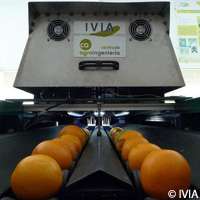Sweet innovation for citrus fruits

Researchers in Spain have developed sophisticated machines to sort citrus fruit before they reach consumers. The prototypes can detect and separate rotten oranges, and can classify mandarin segments. Citrus fruit field pickers can also use these machines to make their jobs a lot easier. The prototypes are presented in the journal Food and Bioprocess Technology.
The conventional method of finding rotten oranges has been to pick and choose the fruit in a dark room, backed by ultraviolet light that illuminates the essential oils in damaged rind through fluorescence. A disadvantage of this method is that the ultraviolet light increases the level of risk for human health; work shifts are therefore timed and performed under a strict schedule. Developed by experts at the Valencian Institute of Agrarian Research (IVIA) in Spain, this latest tool makes the process automatic. The researchers say these prototypes use computer vision to automatically inspect the fruits.
'Through collaboration with a company within this sector, we have developed software and hardware that can locate rotten citrus fruits and discard of those that are not fit for sale,' says Jose Blasco of the IVIA, a member of the team that patented the machine.
It should be noted that this machine is one of many agricultural applications created by these experts in the last two decades. These would not have been possible without recent innovations in artificial vision, which is a series of techniques that enable a computer to be programmed in order for it to 'understand' the image it 'faces' and act accordingly.
Another prototype classifies citrus fruits on the production line. The factors that are taken into account during this classification process are quality, colouring and type of damage that the fruit's skin presents. Top-notch fruits slated for more demanding markets are thereby split from those of lower-grade quality (these are still 100% edible, however). The latter group contain small defects like scratches or bruises. Between 15 to 20 pieces of fruit per second are analysed through this system.
Once the fruits have been divided and separated on a vibrating platform, they are transported on a conveyor belt to the inspection area, capable of assessing 28 segments per second. The broken segments are separated from the whole segments. The machine can also identify which fruits contain pips, and can eliminate skin and other foreign bodies from the production line.
'As well as developing property statistical and computing techniques, the prototypes use the highest image resolution that modern equipment can achieve,' Dr Blasco says. 'They are capable of analysing objects in regions of the electromagnetic spectrum that the human eye cannot see, such as ultraviolet and infrared,' he adds.
'We have even started to inspect the internal quality of fruit using magnetic imaging resonance (MRI), computerised axial tomography (CAT) or X-rays, like those that are used in medicine. Although at the moment, these are costly techniques and we must continue in our investigations so as to facilitate their installation and make them more efficient in the fruit selection process.'
More information: Food and Bioprocess Technology: www.springer.com/food+science/journal/11947
Provided by CORDIS
















